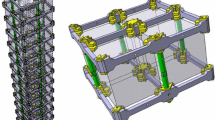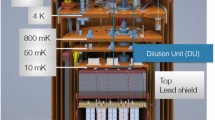Abstract
The Cryogenic Dark Matter Search (CDMS) II uses crystals operated at milliKelvin temperature to search for dark matter. We present the details of the profile likelihood analysis of 140.2 kg-day exposure from the final data set of the CDMS II Si detectors that revealed three WIMP-candidate events. We found that this result favors a WIMP+background hypothesis over the known-background-only hypothesis at the 99.81 % confidence level. This paper is dedicated to the description of the profile likelihood analysis dedicated to the CDMSII-Si data and discusses such analysis techniques in the scope of rare event searches.



Similar content being viewed by others
Notes
It is worth noticing that in the light of this result, the SuperCDMS collaboration has decided to consider 22 kg of Si detectors and 150 kg of Ge detectors for the proposed SuperCDMS SNOLAB experiment. That will enable the SuperCDMS experiment to probe the entire CDMS II Si allowed region presented in Fig. 1 with both Si and Ge target nuclei.
Note that considering also the phonon timing and ionization yield information in the likelihood calculation could potentially improve the discrimination power between the WIMP and the background interpretation of the observed events. However, that would require higher statistics in order to get a robust and accurate estimation of the different PDFs over the whole three dimensional parameter space.
References
R. Agnese et al. [CDMS Collaboration], [arXiv:1304.4279 [hep-ex]].
E. Aprile et al. [XENON100 Collaboration], Phys. Rev. D 84, 052003 (2011) [arXiv:1103.0303 [hep-ex]].
S. Yellin, Phys. Rev. D 66, 032005 (2002)
G. Cowan, K. Cranmer, E. Gross, O. Vitells, Eur. Phys. J. C71, 1554 (2011)
K.A. McCarthy, PhD thesis, Massachusetts Institute of Technology (2013).
J. Billard, F. Mayet, D. Santos, Phys. Rev. D 85, 035006 (2012)
Acknowledgments
The CDMS collaboration gratefully acknowledges the contributions of numerous engineers and technicians; we would like to especially thank Dennis Seitz, Jim Beaty, Bruce Hines, Larry Novak, Richard Schmitt and Astrid Tomada. In addition, we gratefully acknowledge assistance from the staff of the Soudan Underground Laboratory and the Minnesota Department of Natural Resources. This work is supported in part by the National Science Foundation the Department of Energy, the Swiss National Foundation, the NSERC Canada and by MULTIDARK.
Author information
Authors and Affiliations
Corresponding author
Rights and permissions
About this article
Cite this article
Billard, J. Profile Likelihood Ratio Analysis Techniques for Rare Event Signals. J Low Temp Phys 176, 966–972 (2014). https://doi.org/10.1007/s10909-013-1018-z
Received:
Accepted:
Published:
Issue Date:
DOI: https://doi.org/10.1007/s10909-013-1018-z




